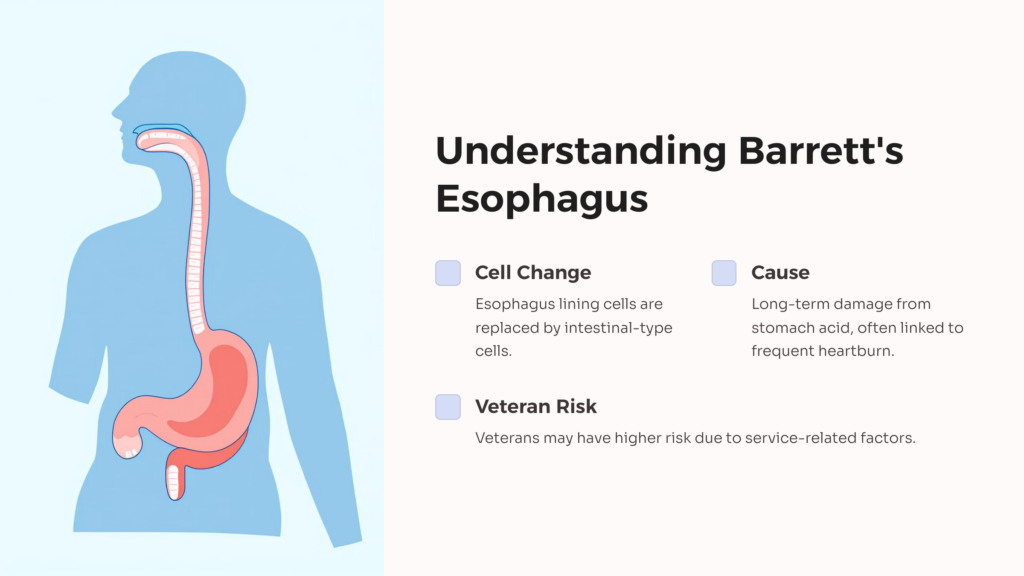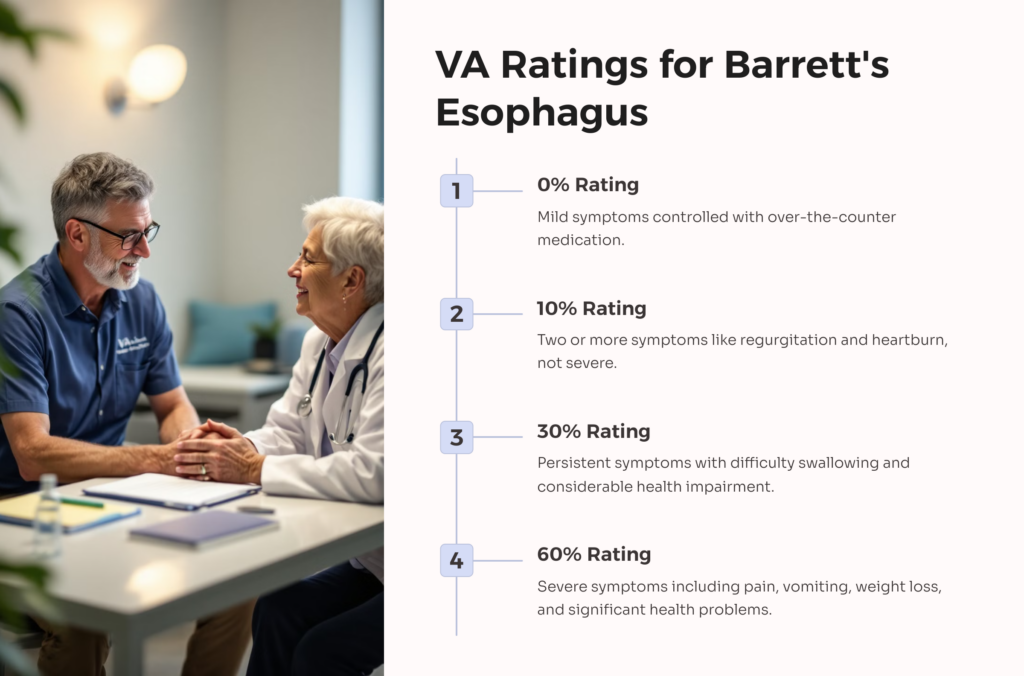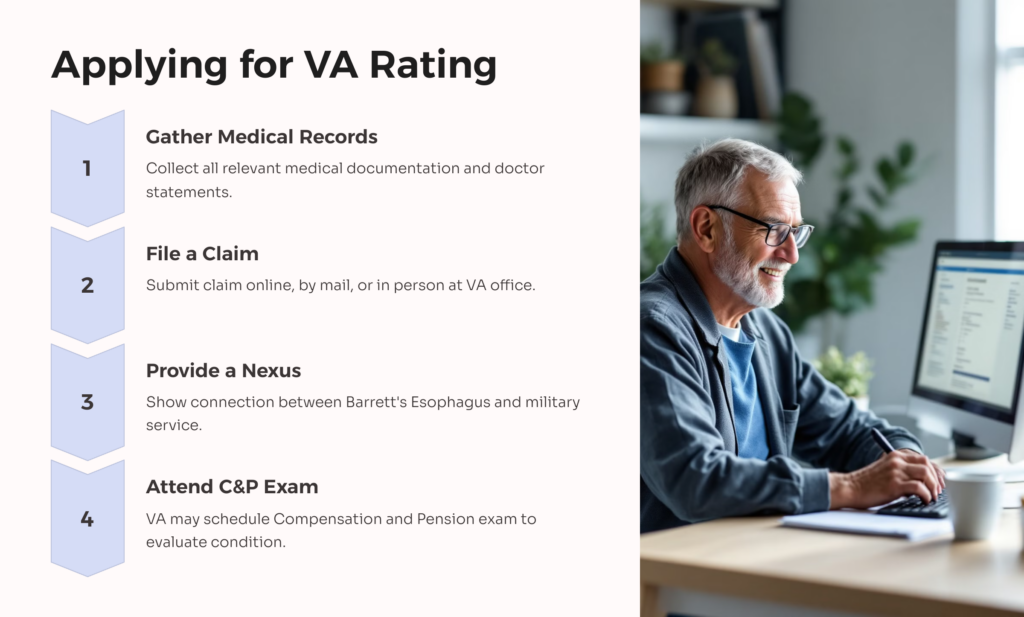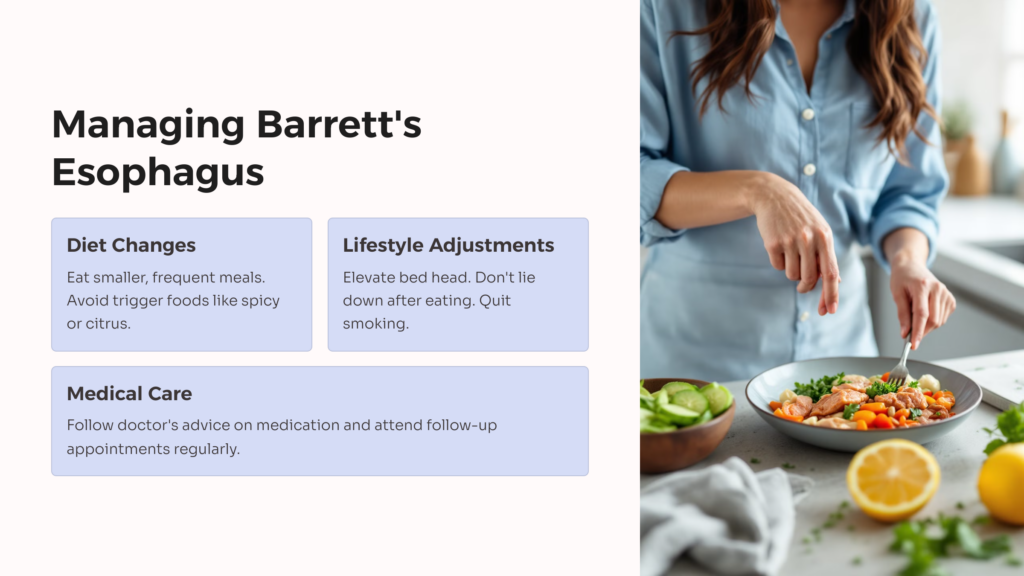Barrett’s Esophagus is a condition where the lining of the esophagus (the tube that connects your mouth to your stomach) changes. Normally, the esophagus is lined with flat, smooth cells. In Barrett’s Esophagus, these cells are replaced by a type of cell usually found in the intestines.

This change happens because of long-term damage from stomach acid. People with frequent heartburn or acid reflux are more likely to develop Barrett’s Esophagus. It’s important to note that while Barrett’s Esophagus itself doesn’t cause symptoms, it can increase the risk of developing esophageal cancer.
Veterans who have served our country may be at higher risk for Barrett’s Esophagus due to factors like stress, diet, and exposure to certain chemicals during service. That’s why the Department of Veterans Affairs (VA) recognizes Barrett’s Esophagus as a condition that may qualify for disability benefits.
Symptoms and Diagnosis of Barrett’s Esophagus
Barrett’s Esophagus itself doesn’t cause symptoms. However, many people with this condition experience symptoms related to acid reflux or GERD (Gastroesophageal Reflux Disease). These symptoms may include:
- Heartburn
- Difficulty swallowing
- Chest pain
- Feeling like food is stuck in your throat
- Frequent burping
- Sore throat or cough that won’t go away
To diagnose Barrett’s Esophagus, doctors usually perform an endoscopy. This is a procedure where a thin, flexible tube with a camera is inserted down your throat to look at your esophagus. The doctor will also take small tissue samples (biopsies) to check for cell changes under a microscope.
For veterans seeking a VA rating for Barrett’s Esophagus, it’s crucial to have a clear diagnosis and documentation of symptoms. Keep a record of how often you experience symptoms and how they affect your daily life. This information can be valuable when applying for VA disability benefits.
Understanding VA Ratings for Barrett’s Esophagus

The VA rates Barrett’s Esophagus based on how severely it impacts a veteran’s life. The rating system is designed to compensate veterans for the average decrease in earning capacity resulting from their service-connected conditions.
Barrett’s Esophagus is often rated under the diagnostic code for hiatal hernia (Code 7346) because it shares similar symptoms. However, in some cases, it may be rated under other codes depending on the specific symptoms and complications.
The VA uses a percentage-based system for ratings, with higher percentages indicating more severe conditions. For Barrett’s Esophagus, ratings can range from 0% to 60%, depending on the frequency and severity of symptoms.
It’s important to understand that even if you receive a 0% rating, you’re still considered service-connected for the condition. This can be beneficial if your condition worsens in the future or if you develop related conditions.
Criteria for VA Ratings: How Barrett’s Esophagus is Evaluated
When evaluating Barrett’s Esophagus for a VA rating, several factors are considered:
1. Frequency and severity of symptoms
2. Impact on daily activities and work
3. Need for medication or other treatments
4. Presence of complications like strictures or ulcers
The VA looks at these factors to determine how much your condition affects your ability to work and live a normal life. For example, if you have frequent heartburn that disrupts your sleep and makes it hard to concentrate at work, you might receive a higher rating than someone with occasional mild symptoms.
It’s crucial to provide detailed information about your symptoms and how they affect you when applying for a VA rating. Keep a symptom diary and gather statements from family members or coworkers who have witnessed how your condition impacts you.
Common VA Rating Percentages for Barrett’s Esophagus
While individual cases can vary, here are some common VA rating percentages for Barrett’s Esophagus:
- 0%: Symptoms are mild and controlled with over-the-counter medication
- 10%: Two or more symptoms like regurgitation and heartburn, but not severe
- 30%: Persistent symptoms with difficulty swallowing, chest pain, and considerable health impairment
- 60%: Severe symptoms including pain, vomiting, weight loss, and significant health problems
Remember, these are general guidelines. Your specific rating will depend on your individual case and the evidence you provide. It’s possible to receive a rating between these percentages if your symptoms fall between two levels.
How to Apply for a VA Rating for Barrett’s Esophagus

To apply for a VA rating for Barrett’s Esophagus, follow these steps:
1. Gather your medical records: Collect all relevant medical documentation, including diagnosis, treatment records, and any statements from your doctors.
2. File a claim: You can file a claim online through the VA’s eBenefits portal, by mail, or in person at a VA regional office.
3. Provide a nexus: You’ll need to show that your Barrett’s Esophagus is connected to your military service. This could be through direct service connection (it started during service) or secondary service connection (it’s related to another service-connected condition).
4. Attend a C&P exam: The VA may schedule you for a Compensation and Pension exam to evaluate your condition.
5. Wait for a decision: The VA will review your claim and send you a decision letter.
Remember, the process can take several months. Be patient and don’t hesitate to follow up if you haven’t heard anything after a few months.
Secondary Conditions Linked to Barrett’s Esophagus
Barrett’s Esophagus can sometimes lead to or be associated with other conditions. These are known as secondary conditions, and they may also be eligible for VA disability benefits. Some potential secondary conditions include:
- Esophageal cancer
- Esophageal strictures (narrowing of the esophagus)
- Chronic cough or asthma-like symptoms
- Sleep apnea
- Dental problems due to acid reflux
If you develop any of these conditions and believe they’re related to your Barrett’s Esophagus, be sure to document them and inform the VA. You may be eligible for additional compensation.
It’s also worth noting that Barrett’s Esophagus itself can sometimes be considered a secondary condition to GERD or hiatal hernia. If you’re already service-connected for one of these conditions, it might be easier to get a rating for Barrett’s Esophagus.
Appealing a VA Rating Decision for Barrett’s Esophagus
If you disagree with the VA’s decision on your Barrett’s Esophagus rating, you have the right to appeal. Here’s what you need to know:
1. Read your decision letter carefully: It will explain why the VA made their decision and what evidence they considered.
2. Gather new evidence: If you have new medical records or can get additional statements from doctors, gather this information.
3. File a Notice of Disagreement: You have one year from the date of your decision letter to file this notice.
4. Consider getting help: Veterans Service Organizations (VSOs) or VA-accredited attorneys can help you navigate the appeals process.
5. Be prepared for a longer process: Appeals can take time, sometimes several years. Stay patient and persistent.
Remember, an appeal doesn’t guarantee a better outcome, but it’s your right to pursue if you believe the initial decision was incorrect.
Impact of Barrett’s Esophagus on Daily Life and Employment
Living with Barrett’s Esophagus can significantly affect your daily life and ability to work. Some common challenges include:
- Difficulty eating certain foods
- Disrupted sleep due to nighttime reflux
- Anxiety about potential cancer risk
- Limitations on physical activities that might trigger symptoms
- Need for frequent doctor visits and procedures
In the workplace, Barrett’s Esophagus might impact your performance if you’re experiencing frequent symptoms or side effects from medication. You might need to take more breaks, avoid certain work-related activities, or miss work for medical appointments.
When applying for a VA rating, it’s important to clearly explain how your condition affects your daily life and work. Specific examples can help the VA understand the full impact of your condition.
Tips for Managing Barrett’s Esophagus

While a VA rating can provide important benefits, managing your condition is crucial for your overall health. Here are some tips:
- Follow your doctor’s advice on medication and follow-up appointments
- Eat smaller, more frequent meals instead of large meals
- Avoid foods that trigger your symptoms (common triggers include spicy foods, citrus, and chocolate)
- Don’t lie down right after eating\
- Elevate the head of your bed to reduce nighttime reflux
- Quit smoking if you smoke
- Maintain a healthy weight
- Manage stress through relaxation techniques or counseling
Remember, everyone’s experience with Barrett’s Esophagus is different. What works for one person might not work for another. Be patient as you find the management strategies that work best for you.
Resources and Support for Veterans with Barrett’s Esophagus
Living with Barrett’s Esophagus can be challenging, but you’re not alone. Here are some resources that might be helpful:
- VA Health Care: If you’re enrolled in VA health care, you can access specialized care for digestive conditions.
- Veterans Service Organizations (VSOs): Organizations like the American Legion or Disabled American Veterans can provide support and assistance with VA claims.
- Support Groups: Look for local or online support groups for people with Barrett’s Esophagus or GERD.
- VA Claims Insider: Provides information and resources about VA ratings for Barrett’s Esophagus.
- National Cancer Institute: Offers detailed information about Barrett’s Esophagus and associated cancer risks.
Don’t hesitate to reach out for help if you’re struggling. Your health and well-being are important, and there are people and organizations ready to support you.
Remember, while living with Barrett’s Esophagus can be challenging, with proper management and support, many veterans lead full and active lives. Stay informed, follow your treatment plan, and don’t hesitate to advocate for the care and benefits you need and deserve. Take our free medical evidence screening and start towards your benefits today, at AllVeteran.com.
 AllVeteran.com Advisors
AllVeteran.com Advisors
With expertise spanning local, state, and federal benefit programs, our team is dedicated to guiding individuals towards the perfect program tailored to their unique circumstances.











